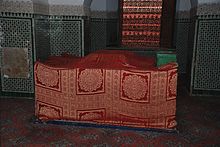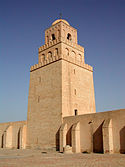Qadi Iyad
Qāḍī ʿIyāḍ | |
|---|---|
| Title | |

ʿIyāḍ ibn Mūsā (1083–1149) (
Biography
Birth and education
Iyaḍ was born in Ceuta,[10] into an established family of Arab origin.[5] As a scion of a notable scholarly family, ʿIyad was able to learn from the best teachers Ceuta had to offer. The judge Abu ʿAbd Allah Muhammad b. ʿIsa (d. 1111) was ʿIyad's first important teacher and is credited with his basic academic formation. Growing up, ʿIyad benefited from the traffic of scholars from al-Andalus, the Maghrib, and the eastern Islamic world. He became a prestigious scholar in his own right and won the support of the highest levels of society.[11]
In his quest for knowledge, Iyad spent part of 1113 and 1114 visiting Cordoba, Murcia, Almeria, and Granada. He received ijāzas from the most important traditionist of his time, Abū ʿAlī al-Ṣadafī (d. 1120) in Murcia, and met with some of the most celebrated scholars of the moment, such as Ibn Rushd (d. 1126), and Ibn Hamdin (d. 1114).[12]
Career
ʿIyad was appointed judge of Ceuta in 1121 and served in the position until 1136. During his tenure as judge of Ceuta he was extremely prolific. Iyad's overall fame as a jurist and as a writer of fiqh (positive law) was based on the work he did in this city.
Exile and death
He died in 1149.
Influence
In doctrine Iyad to known have influenced later scholars like
Cadi Ayyad University, also known as the University of Marrakech, was named after him. Qadi Ayyad is also well known as one of the seven saints of Marrakech and is buried near Bab Aïlen.
Works
Qadi `Iyad's other well-known works include:
- Ikmal al-mu`lim bi fawa'id Muslim, a famous commentary on Sahih Muslim which transmitted and expanded upon al-Maziri's own commentary, al-Mu`lim bi-fawa'id Muslim. Qadi `Iyad's own commentary was utilised and expounded upon heavily by Al-Nawawi in his own commentary of Sahih Muslim.
- Bughya al-ra'i lima Tadmanahu Hadith Umm Zara` min al-Fawa'id, published with Tafsir nafs al-Hadith by Al-Suyuti.
- al-I`lam bi Hudud Qawa'id al-Islam, written on the five pillars of Islam.
- al-Ilma` ila Ma`rifa Usul al-Riwaya wa Taqyid al-Sama`, a detailed work on the science of Hadith.
- Mashariq al-Anwar `ala Sahih al-Athar, based on Imam Bukhari and Sahih Muslim by Muslim ibn al-Hajjaj.
- al-Tanbihat al-Mustanbata `ala al-kutub al-Mudawwana wa al-Mukhtalata.
- Daqa`iq al-akhbar fi dhikr al-janna wa-l-nar, an "eschatological manual" describing the joys of jannah (heaven) and the horrors of jahannam (hell)
See also
- List of Ash'aris and Maturidis
References
- ISBN 9780791439678.
- ISBN 9781438417066.
- Gibril Fouad Haddad (2 May 2015). THE BIOGRAPHIES OF THE ELITE LIVES OF THE SCHOLARS, IMAMS & HADITH MASTERS Biographies of The Imams & Scholars. Zulfiqar Ayub. p. 164.
Imam al-Subki mentions him among those who followed the school of Imam Ashari in Beliefs & Doctrine (Aqidah) along with Abu al-Walid al-Baji, Abu al-Hasan al-Qabisi, Abu al-Qasim bin Asakir, Abu al-Hasan al-Muradi, Abu Sad bin al-Samani, Abu Tahir al-Silafi, Qadi Iyad and Al-Shahrastani
- ^ Mohammed Sijelmassi, André Miquel, Royal Illuminated manuscripts of Morocco, p.62,
- ^ ISBN 978-90-04-25452-7
- ISBN 9781107106666.
- ISBN 9781787380035.
- ^ Mohammad Ilyas, Syed Kamarulzaman Kabeer (3 June 2008). Unified World Islamic Calendar Sharia' Science and Globalization. Arabic Virtual Translation Center. p. 66.
- ISBN 9781135030414.
- ^ J. F. P. Hopkins, Nehemia Levtzion, Corpus of early Arabic sources for West African history, p.101,
- ISBN 978-90-04-25452-7
- ^ ISBN 978-90-04-25452-7
- ^ "Ibn Mada'(Ahmad ibn Abdul Rahman-) Ibn Mada'(Ahmad ibn Abdul Rahman-)". Archived from the original on 2018-02-18. Retrieved 2012-12-23.
- ISBN 9789004255883.
- ISBN 9789004234246
- ^ Nagel, Tilman. 2001. Das islamische Recht. Eine Einführung. Westhofen: WVA Skulima, p.295; quoted in Schirrmacher, Christine (2020). "Leaving Islam". In Enstedt, Daniel; Larsson, Göran; Mantsinen, Teemu T. (eds.). Handbook of Leaving Religion (PDF). Brill. p. 83. Retrieved 6 January 2021.
- ISBN 978-90-04-25452-7
- The Encyclopaedia of Islam. New Edition. Brill Publishers, Leiden. Bd. 4, S. 289
Bibliography
- Dictionnaire historique de l'islam, de Janine Sourdel et Dominique Sourdel, édition PUF.
- Ahmad al Maqqari al Tilimsani, Azhar al Riyad fi Akhbar al Qadi 'Ayyad (biography and works of Qadi Ayyad), 5 volumes
- "Qadi Iyad's Rebellion against the Almohads in Sabtah (A. H. 542–543/A. D. 1147–1148) New Numismatic Evidence", by Hanna E. Kassis, Journal of the American Oriental Society, Vol. 103, No. 3 (July–Septempber, 1983), pp. 504–514
External links
- Islamophile.org, extensive article on his life and work, in French
- His grave, the Koubba Cadi Ayyad, near Bab Aylen in Marrakesh Cadi Ayyad Ben Moussa : les tombeaux de Marrakech
- Talbi, M. (1960–2005). "ʿIyāḍ b. Mūsā". The Encyclopaedia of Islam, Second Edition(12 vols.). Leiden: E. J. Brill.

